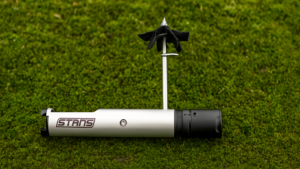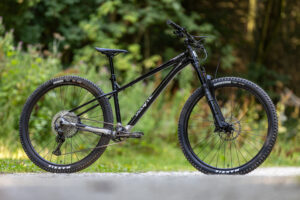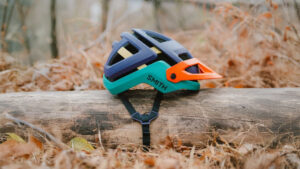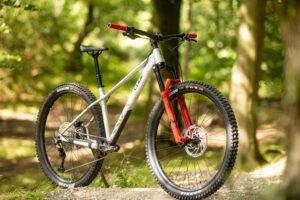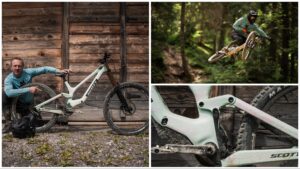The Kado is a brilliant do it all e-bike, if you're into descending I don't think there are many 150mm travel bikes that can touch it for pace
I’ve tested all Whyte’s e-bikes, and the new Kado offers the best blend of power, performance and range… I still find the scintillating E-Lyte more fun to ride though
The Kado is now Whyte’s go to e-bike for most riders, replacing the old E-160 and brushing aside the ELyte. It’s not that the E-160 wasn’t good by the way, but it certainly was heavy and in need of a total overhaul; while the ELyte was always going to be a niche bike, with its small battery, lightweight focus and high price.
Not so the new Kado, the travel is absolutely on point with a now-standard 150mm travel and a 160mm fork. Some of the best electric mountain bikes we’ve seen in 2025 and last year carry this travel, from the superlative Amflow PL Carbon to the latest Specialized Turbo Levo.
– Short of time? Click here to skip to the verdict –
Doing the leg work is Bosch’s latest and boostiest CX motor, so with 100Nm torque and 750w of peak power I can testify it is able to keep the DJI crew within sight on the climbs… just. And with the biggest 800Wh battery on offer you’ll be riding for longer than them too.
More than that, the Kado is one of the most well rounded and thoughtfully put together e-bikes I’ve ridden in a long time. Whyte’s barely put a foot wrong and I can see this RSX version being a stalwart of UK trails.

The Kado is no SL but despite its 24kg weight it’s easy to chuck around and get airborne once you’re up to speed
Whyte Kado RSX need to know
- 150mm travel e-bike, with a 160mm fork and full carbon frame
- Replaces the old Whyte E-160, with the same suspension design
- Whyte has pioneered a low centre of gravity, for easy cornering
- Top end bike gets functional spec with a focus on suspension performance
- 24kg weight and 800Wh battery means this e-bike is no SL
- Powered by the latest Bosch CX Gen 5 motor, which now updates to 750W peak power
Does anyone know what kado actually means though? I had to look it up, but apparently it’s traditional Japanese flower arranging, where the point is to enjoy the beauty of lines and spaces. Yup, makes no sense to me either, but it’s a cool name.

Whyte’s focus has been not on developing the lightest or the most powerful bike, but one that excells on the descents
I think it should have been called the Whyte COG though, which even more of an oddball name but sums up the bike pretty neatly. That’s because Whyte has gone after a low centre of gravity in a big way. Plenty of brands care about getting weight low down in a bike, but Whyte is positively obsessed with the idea. This isn’t new on the Kado, but the Kado has a clocked motor letting Whyte slam the battery lower in the frame.
I’ve always been sceptical about the performance gains this actually delivers though, because it’s impossible to actually test this theory and compare bikes that are similar in every other way. Although I’m hoping the new Orbea Rallon will change that with its removable weight plates letting you add or subtract weight from the BB area.

Clocking the motor means the Kado’s battery actually sits lower down and forward of the CX drive unit, making the bike easier to drop into turns
Back to the Kado though and it’s certainly a good explanation for why this relatively heavy bike corners so well. The theory is lowering the centre of gravity on a bike works by making it easier to tip into corners – there’s less inertia to overcome so less work for you to do. This can make a portly 24kg e-bike feel like an XC whip.
And there is a great opportunity to do this on an e-bike, where shifting the heaviest parts of the bike – the battery and motor at around 5kg – lower even by a few millimetres should make a big difference.
In fact Whyte says the COG is 12.54mm lower than on the outgoing E160 the Kado replaces, which should make it feel like a bobo doll, which I’ll get to in a minute.

In ternal cable routing goes via holes in the headtube, well done Whyte for staying away from headset routing
Frame
There’s not much discernible difference between the new Kado and the old E160 in terms of suspension layout, it uses a Shape.it Link V2 yoke to drive the shock, which bolts to the now straight top tube.
The Whyte Kado range starts at £4,500, with an alloy frame, but this RSX version uses uni direction carbon fibre for both front and rear trigangles. This isn’t done for environmental reasons like Commencal, or to tune the frame, but to keep a lid on costs.

The battery is easy to get out and charge off the bike, and you can swap it for a 600Wh if that’s your thing
The 800Wh battery is removable, but it’s slightly more of a faff than Whytes of old because you have to unclip its connector wires before sliding it out a hatch at the bottom. I remember stories of broken toes from the old E-160, as the battery shot out like a teenager on a waterslide. You can leave your steel toe caps at home on the Kado though as it seems much more controlled.
Aside from internal cable routing, a rear fender, and a chunky chainstay protector, there’s not much of note going on – no internal storage, no tools stashed anywhere. Overall the effect is a much better looking bike, and while it’s not beautiful it is at least rugged looking… I do hate the Kado lettering on the seatstays though.

With a horst link on the chainstay, Whyte is following along from what made the old E-160 great – brilliant suspension
Suspension
Whyte doesn’t go in for counter rotating links, pivots in weird places (or not there at all) or one piece rear ends. Instead it goes for good old fashioned four bar designs. That’s absolutely fine by me because it’s simple and effective and easy to service yourself.
Case in point, about 200 miles into my time on the Kado, one of the main pivot bolts worked itself loose, something I only figured out while trying to diagnose a creak. It’s a totally simple fix though, the bolts are easy to get to and I just needed two allen keys to tighten the bolt and the collet holding it in place.

Performance Elite level suspension from Fox you’re getting the same Grip X2 damper you’d enjoy on the Factory fork, meaning Whyte has specced this bike wisely
The RSX has some smart suspension component choices too, Whyte has used Performance Elite level shock and fork, which gets the same damper as the Factory level stuff just without the more slippery Kashima coatings. It’s a good setup, although the rear end outperforms the 38 on the front.

The Whyte E-160 RSX I tested a few years back was also low, also slack, and also ridiculously planted because of it
Geometry
My memories of the old E-160 are a few years old now, but I remember how bonkers low that bike seemed at the time. In my mind the Kado is less extreme, but looking at the geometry I measured back in 2020 and it’s pretty much the same deal. The head angle is within 0.1° of the old bike and the bottom bracket barely a millimetre higher.
Whyte does have a flip chip on the Kado, pop it into the high mode and you can compensate for the lower stance of a 27.5in wheel. And unlike on the Teewing and Amflow, where we used this trick to slam the BB height, the Kado is already enough already to scrape the soles of your Five Tens.

I got good range from the Kado, notching up over 1,400m of ascent in a mix of EMTB+ and Turbo
Battery
The ability to take the battery out of your bike isn’t a deal breaker for me, but I know riders for whom it really would be. One has a bike that only emerges from his van at the trailhead, blinking in the light, simply because charging it in a London flat is just not an option.

Whyte’s charger port isn’t as fancy as some, but it’s easy to get to and does the job of keeping water from the electronics
Whyte’s made the process pretty simple, just open the battery cover, undo the captive bolt, unclip the battery connector and slide the battery out. To replace, just do the reverse.
Every Kado can also take both 600Wh and 800Wh batteries, meaning you could feasibly tailor the power pack to your intended length of ride. Both the 600 and 800 are exactly the same size, meaning all you need to do is transfer the end plates from one to the other.

The best e-bike tyre going, in my opinion
Components
Whyte is a UK brand with a great reputation for sensible spec choices, and as such the Kado is absolutely primed for the kind of riding we do in this country. It’s hard to pinpoint anything I’d change on the Kado, excepting the stem, which was just 10mm too short for my preference.
Breaking is down then, the Maxxis tyre combo of Assegai and DHRII is unbeatable on a 150mm trail bike, and Whyte has knowledgably specced a Double Down casing on the back.

I’ve often found Maguras to be finicky things, with pads that need to be aligned just so to stop them squeaking, but I had no problems with the MT7 and the stopping power is unreal
The RSX gets a modest drivetrain with modest SRAM 1000 AXS, but it’s still 12speed AXS and as such shifts faultlessly. The mech is also wired into the bike’s internal battery too, meaning there’s one less thing to charge.
Magura’s MT7 brakes with 203mm rotors stood out for me too because they are relentlessly powerful, something I wouldn’t want to do without on a 24kg.
Performance
It’s hard to find something lacking in the Kado’s performance, it’s one of those bikes that does everything really well… despite being a shade overweight, at 24kg. In a straight line it’s desperately quick and composed, but it’ll fall into corners with the lightest lean and push on the bars.

A steeper seat tube angle would probably aid the Kado on the climbs, but it’s still good thanks to the sensitive suspension
Climbing
I got a sneak peak of Whyte’s new power upgrade before it was released to the public, which helpfully let me compare the uprated 100Nm of torque to the old Whyte ELyte Evo Stag Works‘ 85Nm. And honestly, it’s not that much of a bump. Disappointingly so really.
Part of that disappointment must come from my recent experiences on a DJI-powered Teewing though, a bike that can scramble up ridiculously precipitous fall line climbs without having me out of breath. The Kado can do this too to a certain extent, but you’re breathing pretty heavily at the top.
I could also whine my way up steeper, looser stuff on the DJI bike than I could on the Kado. The reason for this must be the DJI’s superior control over the rear wheel, it senses its speed much more regularly and therefore meters the power better for grip.
That said, the Kado is actually a warrior on the climbs thanks in part to its sensitive and grippy suspension, it uses its weight and poise to find traction pretty much everywhere.
The bike sits super low to the ground too, while the weight also feels more rearward than I was expecting. That helped me unweight the front wheel to shifty it sideways over obstacles or change lines abruptly on climbs. I only really got unstuck trying to physically manhandle it in really slow speed situations, where you definitely feel the weight.

The Kado is a bike that’ll see you right on pretty much any track you can find in the UK, despite having just 150mm travel
Descending
If you’re short on time head to my review of the E-160 and read that more concise conclusion, because I’ll just be repeating myself here. That’s a joke, but one based on a fair chunk of truth because the Kado is a really familiar place to be when descending.
That’s a really good thing though, and I don’t think I’m drinking the Whyte coolaid when I say the Kado is a very easy bike to corner on. And you’re going to hate this old cliche, but most of the time it doesn’t feel like a 24kg trail bruiser.

It’s easy to push for grip and get loads of confidence on this bike
The Kado is lightning fast to lean into corners, lean on the bars and it responds instantly, and the stabilising effect of its weight and geometry means you can get away with ridiculous manouveres, jump into corners and generally behave like your skillset is one notch higher than it really is.
Despite that, getting the wheel up – whether you’re manuallying, mistiming a wheelie, or jumping into a corner – is ridiculously easy, even with a hefty Fox 38 on the front.
Big bikes can’t slow down though, right? The Kado is a master of braking, I prefer this bike to all others on the steepest of fall line tracks because it just seems to dig in and slow you down on the brakes.
And why wouldn’t it kick ass on proper enduro tracks? The suspension is designed for nasty, lumpy trails and doesn’t give up when you’re squishing it into the trail for dear life. It’s low and seems to get even lower on the steeps.
Here’s the but though, I actually prefer the E-Lyte to the Kado. Yes this thing absolutely rips on full on tracks and I was impressed by how many bikes the Kado ate up on BikePark Wales’s hardest trails, despite the very average pilot. I’m looking at you, Santa Cruz Bullit. But mostly I ride mellower, softer trails, lines where you’re required to work the bike more, touch your brakes less and let things go, and here the Kado is overkill.

What e-bikes were made for
Verdict
The Kado is going to be a great bike for the majority of UK riders out there, provided they're not obsessed with having the most powerful motor you can buy. And really it’s reliability, range, value and general bike performance that's actually most important for riders, according to our research, meaning this bike should be top of the list. For all this the Kado's greatness though, it's not the bike for me. I'm deeply unfashionable for saying this but I still prefer the feel of a lightweight e-bike because I find them easier and more engaging to ride on anything other than flat out enduro trails.









